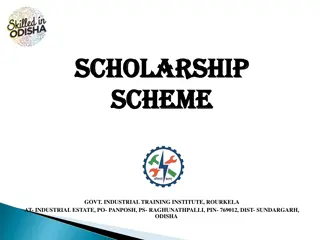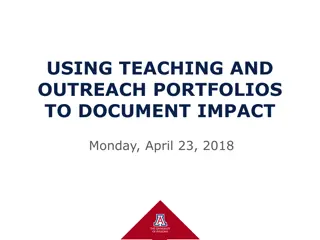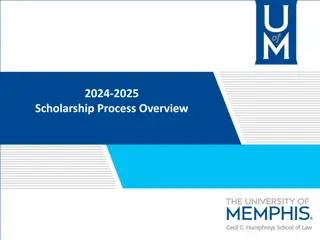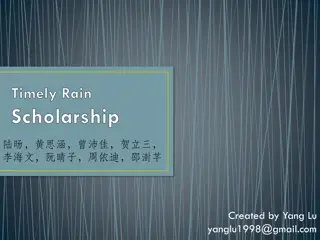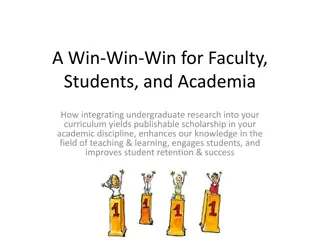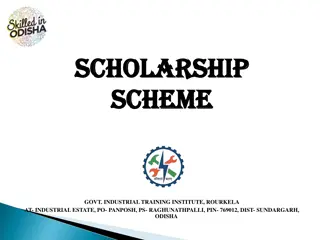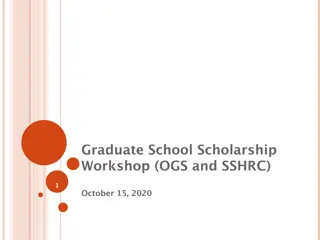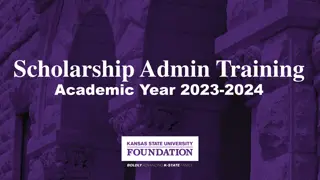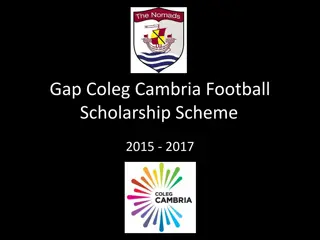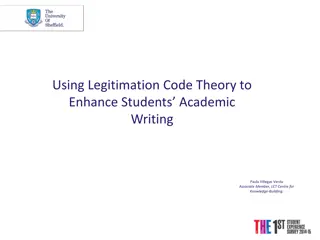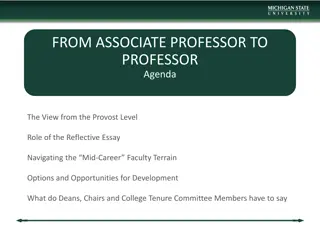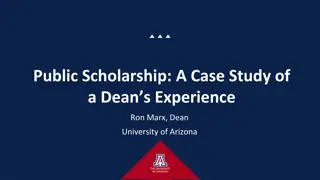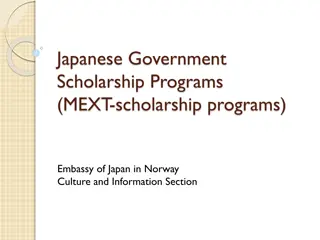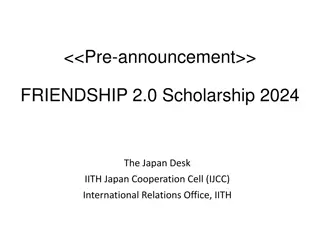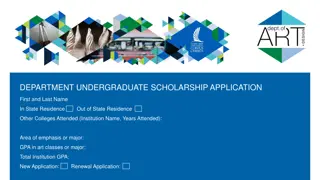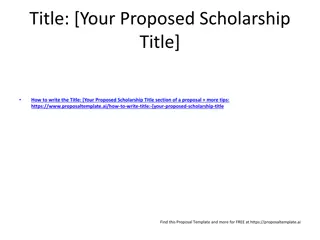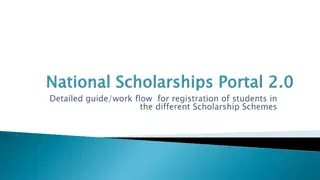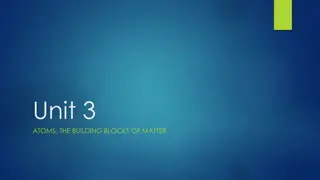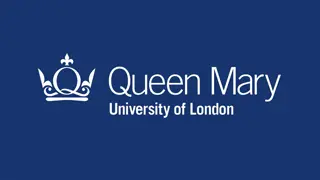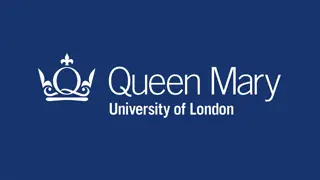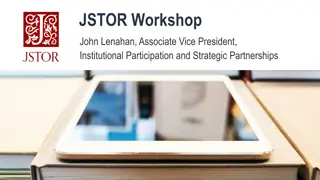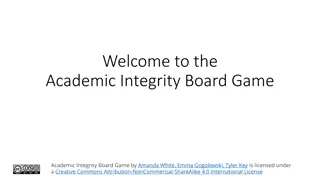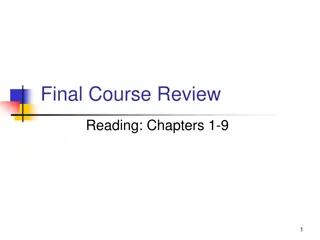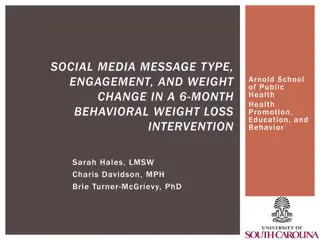Exploring Impact, Scholarship, and Theory in Academic Engagement
Dr. Laetitia Monbec, a Senior Lecturer at the National University of Singapore, delves into the realms of impact, scholarship, and theory, focusing on color semiotics and its significance across various disciplines. The narrative unfolds with a case study on critical thinking and engagement within academic readings, aiming to decipher the essence of reflective responses in higher education. This academic journey navigates through debates on gender-stereotyped color preferences, urging students to critically evaluate and articulate their viewpoints in scholarly discourse.
Download Presentation

Please find below an Image/Link to download the presentation.
The content on the website is provided AS IS for your information and personal use only. It may not be sold, licensed, or shared on other websites without obtaining consent from the author. Download presentation by click this link. If you encounter any issues during the download, it is possible that the publisher has removed the file from their server.
E N D
Presentation Transcript
An exploration of impact, scholarship and theory Dr Laetitia Monbec, Senior Lecturer, National University of Singapore
Thinking through impact: a case study Thinking through impact: a case study Context: Idea and Exposition module (content-based writing credit) at the National University of Singapore. The Semiotics of Colour (Monbec, 2020; 2022; 2023) Students: Psychology, CS, Engineering, Design, Archi, business, FASS, Pharmacy, LS Content: Colour semiotics Colour theory; colour universal vs relativity; colour constancy Social semiotic approach to colour and parametric approach (van Leeuwen 2011) Colour meaning in the social world (identity, power relations, gender, race, affiliation, ) Colour practice (film, marketing, design ) Writing:Reflective summary response; Research Project Proposal OP; Research paper Brooke (Ed.) (2022), Integrating content and language in higher education: Developing academic literacy, Singapore: Springer. (Sports, Risk, Food, The Vampire, Women in Film )
Assignment: Reflective Summary Response Critically respond to a given academic article.The task requires students to summarize a core reading and engage with one of its themes, drawing on additional literature. 600 words Week 5
Expectations Expectations LoBue, V., & DeLoache, J. S. (2011). Pretty in pink: The early development of gender-stereotyped colour preferences. British Journal of Developmental Psychology, 29(3), 656 667. Biological or socially constructed gender-stereotyped colour preferences Students are expected to engage with this debate, which includes expressing judgement about and making connections between a set of knowledge claims and scholars. This is likely to occur through the evaluation of the original source s claims and the use of external sources to support the student s argumentation. In their engagement with this core academic text, students might reflect on the study s results and how they contribute to the debate, or they might reflect on a range of possible reasons for or consequences of this gender stereotyping. They might also relate to more introspective content and draw parallels with personal experiences with dominant discourses around gender norms.
Problem: critical thinking and engagement with readings Recurrent problem with a few students each semester: CT is not the ability to criticise CT is not desperately finding ways to disagree CT is not to dismiss or insult Research question: What characterises the different types of engagement? 1.How do students respond to a core academic reading in the reflective summary response in high and low achievement bands? 2.What does this tell us about students understanding of what constitutes valued reflection and CT in the colour module?
Analytical framework: LCT Axiological cosmologies Cosmologies refer to belief systems that underlie and legitimise practices in social fields. They constitute a vision of the world embodied by activities within the social field (Maton, 2014, p.152) and underpin actors viewpoints, signalling their aesthetic, ethical, moral or political affiliations (Maton, 2014, 152). Actors align their stances to these broader discourses more or less consciously and to different degree (Maton, 2014, p,168). Clusters of axiological meanings charged positively or negatively (Tilakaratna and Szenes, 2020). Clusters build larger constellations within the assignment, or across several texts. +/- evaluation of Target Their study is limited [ opinion]
Analysis of student assignments. What are students doing when they engage critically with knowledge? Systemic functional linguistics: Appraisal (Martin and White, 2005) They evaluated differently: ATTITUDE: How values are built in a text around emotion (affect), or opinions (Judgement and Appreciation) and whether this is negatively ( ) or positively (+) charged. They related to other sources differently: ENGAGEMENT resources Their targets of engagement were different: Field of Study Field of Research (Hood, 2010) 24 scripts ranging from high to low achieving
Low-achieving students: Criticism as reflective response Engage with the field of research. They do not engage with the field of study. Targets: experiment , methods , findings , generalisability , sampling + negative charging Appraisal: The research is limited and cannot be generalised , or The methods are not conclusive. Target cluster 1 Target: the authors LoBue and Deloache Evaluation Charging to a certain extent have exemplified The researchers might not have addressed The authors could have further supported negative They could elaborate more have not addressed cluster 2 Target: field of research (methods) methods not sufficiently conclusive experimental factors could introduce variability negative approach the lack of sensitivity in their maladaptive approach their experiment cluster 3 Target: field of research (results) the authors findings seem convincing (while) the research could have been better substantiated with explanations the findings lack credibility the results are skewed by bias negative less persuasive and convincing could be more robust could be more precise
[1] However, they might not have addressed important factors that could introduce variability in their experiment [ opinion]. Constellation [2] Firstly, the children involved in the authors experiment could already develop similar colour preferences due to shared environmental influences attributed from a Caucasian background. [3] Persaud (2017) argued [distance] that English speakers in the United States exhibit bias patterns [ opinion] in colour memory that differs from individuals from a non-English speaking population. [4] The bias [ opinion] could possiblyskew [ opinion] the experimental findings as children from other racial and ethnic groups could exhibit different preference patterns between certain colours. Authors Incompetent biased [5] Secondly, while the authors justified their methodology of utilising identical objects that differed in colour, Wilcox (2004) raised questions [distance] about how colour priming works. [6] How can viewing one set of events increase infant s sensitivity to colour information in another, separate event? Conclusion: [7] As a result, although the authors may have demonstrated that girls prefer pink and boys avoid pink, the lack of sensitivity in their maladaptive [ opinion] approach renders their claim less persuasive and convincing [ opinion]. Core reading Results Invalid skewed Methods Ill-designed Students engagement with knowledge means evaluating knowledge validity Knowledge validity is evaluated through methodology accuracy. Once the methodology is invalidated, the need to engage with the issue of gender and colour preference is made redundant. A negatively charged constellation of the LoBue and Deloache article
High achieving assignments Targets of evaluation are mostly in the field of study (Hood, 2010) gender- stereotyped colour preference - namely the article s findings, the positions and claims and the study s contribution to knowledge in the field. Targets: No biological basis for gendered colour preference No gendered colour preference in infancy Gender identification and colour preferences are closely intertwined Boys being more susceptible to social pressure Minimal appraisal resources Rich engagement resources (distancing, endorsing)
[8] There is substantial evidence from other sourcesthat stronglyreinforces[endorse] the idea that gender identification and colour preferences are closely intertwined. [9]In a paper cited by the authors, where eight different hues are investigated, the studyfurther concludes [endorse] that there is no evidence[endorse] of different colour preference across the two genders during infancy, which contrasts starkly with older age groups (Franklin, Bevis, Ling, & Hurlbert, 2010). [10] Wong and Hines (2015) further endorse this idea by demonstrating[endorse] how the stability of gender-related colour preference in children increases during the same time where gender stability is attained. [11] In a separate work, Wong and Hines (2014) also verify[endorse] that young boys are more influenced by colour preference compared to young girls, which they discover to be consistent [+opinion]with research which shows [endorse] that young boys are more susceptible to social pressure from their gender group. [12] The high consistency of patternsobserved in children s development of colour preference and gender identification strongly suggests[endorse] that itoccurs not merely by chance, but that children utilise colour preference as a means to identify gender.
Why are they doing it and what is missing in my curriculum? Misunderstanding: the task is not about evaluating, but about engaging with ideas and linking to the literature. Why do they understand critical engagement this way? Pierre Bourdieu: the whole social structure is present in each interaction (and thereby in the discourse uttered). [ ] The concern to return to the things themselves and to get a firmer grip on reality , a concern which often inspires the projects of micro-sociology , can lead one purely and simply to miss a reality that does not yield to immediate intuition because it lies in structures transcending the interaction which they inform (1991, p.67) Karl Maton: [A]ll practices reflect a cosmology (Maton 2014, p.169) Ruqaiya Hasan: The illusion of the powerlessness of language in construing reality, quite paradoxically, becomes the greatest source of its power: it becomes the most powerful instrument for the maintenance of ideology. (Hasan, 1988, as cited in Lukin, 2019, p.1)
CT is a contested term CT is a contested term CT associated with evaluation and construction of arguments and logical analyses . CT associated with the tradition of empiricism, focus on scientific method as legitimate knowledge building. CT as a skill: the ability to evaluate source credibility, and to solve problems; skills to suit the needs of the modern flexible workforce. CT as emancipatory: unearth structural or systemic assumptions. (Bruce, 2020) In Singapore, studies of CT recontextualization in schooling in the city- state, revealed a contested discourse and different understandings of critical thinking according to schooling experience (Lim, 2014; 2016)
CT in Singapore: How is CT recontextualized in the CT in Singapore: How is CT recontextualized in the Educational Discourse Educational Discourse In Singapore, CT and reflective skills are a key aim of education and a central tenet of the educational discourse (Lim, 2014). Critical thinking as human capital ideology in a changing world (Koh, 2002) Ability to analyse and evaluate sources Ability to reflect and find solutions Country s capability to cope with changes in a transient economy (We must adapt!) The National Institute of Education (NIE) Working Paper on Creative and Critical Thinking (Chiam et al., 2014) Healthy skepticism Means to get the right answer NUS General Core Curriculum Documents (2021) Focus on value-free and objective knowledge Open mind Cognitive processes: analysis, synthesis Sensitive to context
CT in educational practices: Elite schools and CT in educational practices: Elite schools and mainstream schools difference mainstream schools difference In mainstream schools, CT is understood as an instrumental skill to get at a right answer or the right way of getting at the answer (Lim, 2016, p.120) in English/humanities disciplines. In the social science subjects: evaluating knowledge claim credibility. In elite schools: CT is taught as part of philosophy programmes: the ability to construct and evaluate arguments and logical analyses especially in relation to scientific methodology and rational enquiry. In Year 1 in NUS: Compulsory Quantitative reasoning module (no Qual equivalent).
Intervention Intervention Addressing problem with broad recommendations : CT is not criticism was too general and too abstract. Teaching Intervention/revision to syllabus: Discussions around CT and different types of engagement with knowledge and texts. Interesting discussions about schooling experiences (Elite, Mainstream, JC, Poly) and orientation to knowledge and CT. Text analyses of similar constellations in texts to show the basis of achievement in this assignment: Target + Appraisal/Engagement Successful impact on students texts and learning
EAP Transfer Literature EAP Transfer Literature Occurs when learning in one context or with one set of materials impacts on performance in another context or with another set of materials (Perkins & Salomon, 1994, p. 6452). Near and far transfer, Low-road and high-road transfer, Mindful abstraction (a bridge from one context to another) Factors affecting transfer: learner s attributes (motivation, self-efficacy, affect..) task similarity ( near/far ) teaching for transfer strategies transfer climate (the way the new context promotes transfer) Curriculum is rarely questioned EAP modules are not detailed= it is just taking and EAP module that is taken into account, regardless of its shape. Archibald (2001); Barnett and Ceci (2002); Dooey (2010); James (2010; 2012; 2014);Terraschke, & Wahid, (2011); Storch & Tapper (2009)
Impact Impact Broad feedback loop: impact can be narrowly-defined in transfer studies (curriculum ignored, context ignored). Need to question our curriculum and approaches within the context of our students disciplines/worlviews/broader social context. Keep both discursive and social context in view to explore underlying causes: What s making students engage with the task in the way they do? Larger impact studies might be enhanced smaller qualitative studies Practitioners are well-positioned to do this type of scholarship
Q and A The Pink and Blue Project, Jeong Mee Yoon (photographer) http://www.jeongmeeyoon.com/aw_pinkblue.htm
References Brooke (Ed.) (2022), Integrating content and language in higher education: Developing academic literacy, Singapore: Springer.Bruce, I. (2020) Expressing Critical Thinking through Disciplinary Texts: Insights from Five Genre Studies, Bloomsbury Publishing. Bourdieu, P. (1991) Language and symbolic power, Oxford, Blackwell. Giroux, H. A. (2020) On critical pedagogy, Bloomsbury Publishing Hood, S. (2010) Appraising Research: Evaluation in Academic Writing, New York: Cambridge University Press. Lim, L. (2014) Critical thinking and the anti-liberal state: the politics of pedagogic recontextualization in Singapore , Discourse: Studies in the Cultural Politics of Education, 35(5), 692 704. Lim, L. (2016) Knowledge, control and critical thinking in Singapore: State ideology and the politics of pedagogic recontextualization, New York: Routledge. Koh, A. (2002) Towards a critical pedagogy: Creating thinking schools in Singapore , Journal of Curriculum Studies, 34(3): 255 264. Maton, K. (2014) Knowledge and knowers: Towards a realist sociology of education, London: Routledge. Martin, J.R, & White, P. R. (2005), The Language of Evaluation. New York: Palgrave Macmillan. Monbec, L. (2020). Scaffolding Content in an Online Content and Language Integrated Learning (CLIL) Module. International Journal of TESOL Studies, 2(2)157-173. Monbec, L. (2022). Multimodal academic literacy: exploring the valued gaze in a colour semiotics module. In M. Brooke (Ed.) Integrating content and language in higher education: Developing academic literacy. Singapore: Springer. Monbec, L (2023). Understanding students' reflective engagement with academic texts. In N. Tilakaratna & E. Szenes (Eds.) Demystifying Critical Reflection: Improving pedagogy and practice with Legitimation Code Theory. Legitimation Code Theory: Knowledge-Building in Research and Practice Series. Routledge. Tilakaratna, N. & Szenes, E. (2020) Uncritical reflection: Uncovering disciplinary values in social work and business reflective writing assignments , in C. Winberg, S. Mckenna, and K. Wilmot (eds) Building Knowledge in Higher Education: Enhancing teaching and learning with Legitimation Code Theory, Abingdon: Routledge. Van Leeuwen, T. (2011) The Language of Colour: An introduction, Abingdon: Routledge
It is an ongoing process of semiotic development whose culmination consists in enabling the activity of reflection on the discourses prevalent in one's society, including reflection on the social and semiotic conditions for the occurrence of these discourses; on the social bases of their legitimation; on the structuring of their content, both ideational and interpersonal; and on the differentially valued possibilities of textual forms as variant realization of some specific material-semiotic action. In short, this view of literacy integrates reflection on literacy as an essential part of the process of becoming literate. This view of literacy suggests a Vygotskian understanding of the relations between language use and human consciousness. It is also in agreement with the current tendency to see the term as largely synonymous with education. To equate the processes of literacy with those of education is to affirm not only the centrality of language across the curriculum, but also to think of the processes of teaching/learning as essentially the exchange of meanings, and to think of this exchange of meanings as a specific kind of abstract tool for the development of the consciousness 5 of those involved in such processe Debates about literacy include ideas about the relations of language and society and whether education has a liberating mission, pedagocial action as a liberating force Rukaya Hasan Hasan, Ruqaiya. "The disempowerment game: Bourdieu and language in literacy." Linguistics and education 10, no. 1 (1998): 25-87.
CT in the broader CT in the broader broader broader context context Lim sees a contradition in the embedding of an instructional discourse that is heavily laden with both neoliberal and liberal aspirations in an illiberal regulatory discourse. Specifically, it involves the teaching of critical thinking- not only one of the foremost analytical skills prized in an information dense knowledge economy but, also [ ], both the form of and the means to esoteric, emancipatory knowledge in an authoritarian society. (p10)


